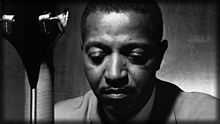Freddie Green
| Freddie Green | |
|---|---|
 | |
| Background information | |
| Birth name | Frederick William Green |
| Born |
March 31, 1911 Charleston, South Carolina United States |
| Died |
March 1, 1987 (aged 75) Las Vegas, Nevada United States |
| Genres | Jazz |
| Occupations | Musician |
| Instruments | Guitar |
| Associated acts | Count Basie |
| Website | www.freddiegreen.org |
Frederick William "Freddie" Green (March 31, 1911 – March 1, 1987) was an American swing jazz guitarist. He was especially noted for his sophisticated rhythm guitar in big band settings, particularly for the Count Basie orchestra, where he was part of the "All-American Rhythm Section" with Basie on piano, Jo Jones on drums, and Walter Page on bass.
Early life and education
Green was born in Charleston, South Carolina on March 31, 1911. He was exposed to music from an early age, and learned the banjo before picking up the guitar in his early teenage years. A friend of his father by the name of Sam Walker taught a young Freddie to read music, and keenly encouraged him to keep up his guitar playing. Walker gave Freddie what was perhaps his first gig, playing with a local community group with whom Walker was an organizer. Another member of the group was William "Cat" Anderson, who went on to become an established trumpeter, working with notable figures such as Duke Ellington.[1]
Career
It was around this time that Green's parents died, and he moved to New York to live with his aunt and continue his education. The move opened up a new musical world to Freddie. While still in his teens, he began to play around the clubs of the city, earning money and a reputation. In one of these gigs, he was noticed by the legendary talent scout John H. Hammond, who realized the potential of Green and introduced him to Basie.[2]
In 1937, Basie and his ensemble went to one of Green's gigs on the advice of an associate. Basie was an immediate fan, and approached Green with a job offer, which he accepted. Except for a brief interruption, Freddie Green would remain a pivotal fixture of the Count Basie Band for the next fifty years.[2]
"You should never hear the guitar by itself. It should be part of the drums so it sounds like the drummer is playing chords—like the snare is in A or the hi-hat in D minor"Throughout his career, Green played rhythm guitar, accompanying other musicians, and he rarely played solos. "His superb timing and ... flowing sense of harmony ... helped to establish the role of the rhythm guitar as an important part of every rhythm section."[3]:100 Green did play a solo on the January 16, 1938 Carnegie Hall concert that featured the Benny Goodman big band. In the jam session on Fats Waller's "Honeysuckle Rose," Green was the rhythm guitarist for the ensemble, which featured Basie, Page, and musicians from Duke Ellington's band. After Goodman's solo, he signalled to Green to take his own solo, which the musician Turk Van Lake described in his commentary on the reissued 1938 Carnegie Hall concert as a "startling move."[4] Green's solo occurs between those of Goodman and trumpeter Harry James.[citation needed]
He rapidly changed chords, often with every beat, rather than every measure. His chord fingering often involved him covering four strings with his fingers, while depressing only a subset of the notes. He dampened the unsounded notes from chords with his left hand.[5] This technique gave a 'chunky' rhythm sound without creating unnecessary harmonic presence that might interfere with notes sounded by other members of the orchestra.[citation needed] Green's playing on his signature Stromberg guitar was the model for Ralph Patt's big-band playing.[6]
Green died of a heart attack in Las Vegas, Nevada at the age of 75.[7]
Discography
With Sonny Stitt
- Sonny Stitt Plays Arrangements from the Pen of Quincy Jones (1955, Roost)
- Sonny Stitt Plays (Roost, 1955)
With Teri Thornton
- Devil May Care (1961, Riverside)
With Count Basie
- Count Basie and the Kansas City 7 (1962, Impulse!)
- Basie Swingin' Voices Singin' (1966, EMI)
- Loose Walk (with Roy Eldridge) (1972, Pablo)
- Satch and Josh (with Oscar Peterson)
- Kansas City 8: Get Together (1979, Pablo)
- Mostly Blues...and Some Others (1983, Pablo)
With Sarah Vaughan
- Sarah Vaughan in Hi-Fi (1949, Columbia)
- No Count Sarah (with the Count Basie Orchestra) (1958), EmArcy)
- Count Basie/Sarah Vaughan (with the Count Basie Orchestra) (1961, Roulette)
- Send in the Clowns (with the Count Basie Orchestra) (1981, Pablo)
References
- ↑ Ferguson, Jim (August 1987). "Freddie Green - Mr. Rhythm Remembered". Guitar Player (NewBay Media). ISSN 0017-5463.
- ↑ 2.0 2.1 "Swing Music History". Tom Smith Big Band. Retrieved 12 January 2010.
- ↑ 3.0 3.1 Denyer, Ralph (1982). The New Guitar Handbook. Pan Books. ISBN 978-0330327503.
- ↑ Van Lake, Turk (1999). The Famous 1938 Carnegie Hall Jazz Concert (Media notes). Benny Goodman. Sony.
- ↑ Pettersen, Michael (February 2004). "Freddie Green's Rhythm Guitar Style Revisited". Down Beat (Maher Publications). ISSN 0012-5768.
- ↑ Peterson, Jonathon (2002). "Tuning in thirds: A new approach to playing leads to a new kind of guitar". American Lutherie: The Quarterly Journal of the Guild of American Luthiers (The Guild of American Luthiers) 72 (Winter): 36. ISSN 1041-7176.
- ↑ Page, Tim (2 March 1987). "Freddie Green is Dead at 75; Guitarist in Count Basie Band". The New York Times.
External links
- Freddie Green at AllMusic
- Freddie Green discography at Discogs
- Freddie Green at the Internet Movie Database
- Freddie Green at Find a Grave
|